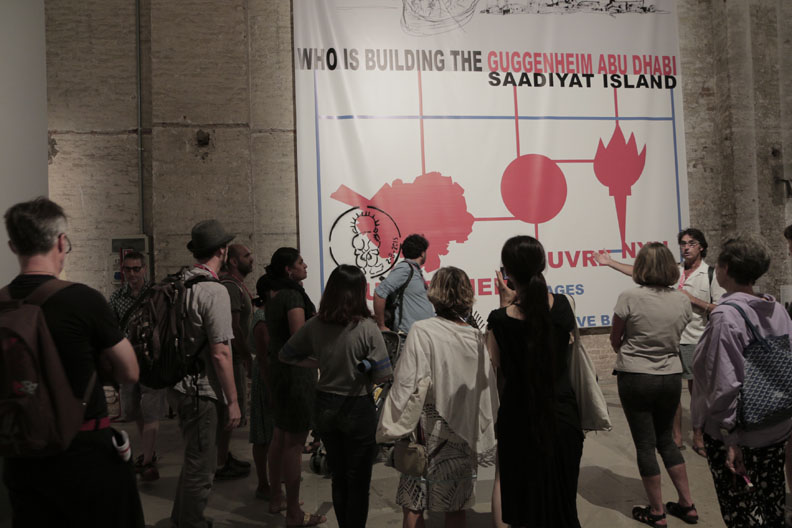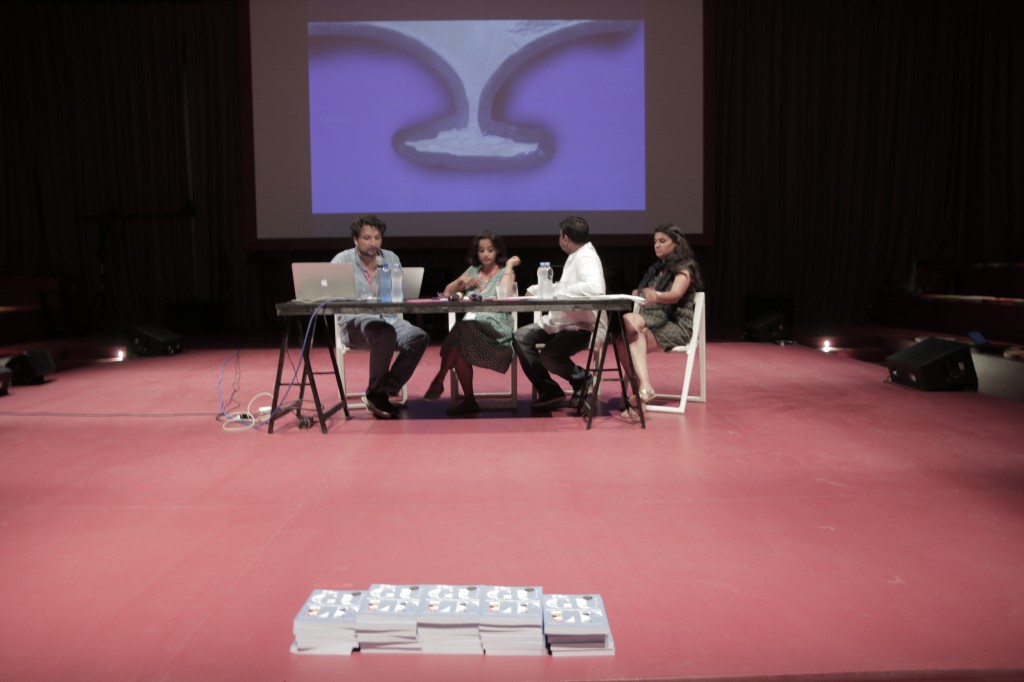An intervention at the Biennale: G.U.L.F and Gulf Labor at Venice.
August 2, 2015.
1330 hrs.
The banner that marks the participation of the Gulf Labor Coalition at the 56th Venice Biennale in the Arsenale receives an intervention.
1500-1645 hrs.
The migration panel in the Arena reframes the discussion around migrant labor in the UAE, and on Saadiyat island.
http://www.labiennale.org/en/
16:45 hrs.
G.U.L.F members read a Statement on Palestine in the Arena.
17:00 hrs.
A PUBLIC MEETING is called for at the Israeli Pavilion; the pavilion is occupied
1330 hrs.
At one thirty pm. on Sunday, August 2, the banner marking the participation of Gulf Labor in the 56th Venice Biennale welcomed the presence of Handala. The banner is currently hanging inside the Arsenale exhibition hall. A one-metre diameter stencil of Handala was spray painted in black onto the banner by members of G.U.L.F. in the presence of approximately twenty biennale visitors.
Handala is an iconic symbol of Palestinian Resistance created in the seventies by Naji al – Ali while he lived as a stateless migrant in the Gulf; it takes on profound dimensions on this banner. As a universal symbol of solidarity, it speaks for the indifference of both the UAE authorities and museums like the Guggenheim and the Louvre, and universities like NYU in taking action on the issues of the migrant workers building the Saadiyat island. The image of Handala: the ten year old boy who turned his back to a world that will not bring the occupation of his homeland to justice also brings Palestine into the picture; workers made stateless on their own land, compelled to cross checkpoints and work on building Israeli Settlements, homes and military establishments.
14:30 hrs.
This was followed by a Panel on Migration and the Gulf Dream with Ashok Sukumaran, Paula Chakarvartty, Nitasha Dhillon, Parimal Sudhakar.
http://www.labiennale.org/en/art/news/29-07c.html
The panel brought in history, context and voices of migrant workers from South Asia—with an emphasis on India—and their experiences and role as political actors in shaping social justice initiatives in India, the GCC and beyond.
Ashok Sukumaran began the panel with a visual account of the rich geography of trade and flows of people to people relations that have long connected South Asia to the Middle East through the Indian Ocean. He discussed the ways in which the modern constructs of both the maritime museums and the labor camps in the UAE (Sadiyaat Island in particular) disrupt and limit South Asian workers/migrants’ complex relationship to the region. Paula Chakravartty discussed how the issue of migrant labor rights in the Gulf has been framed in the Western media problematically, either through the PR lens of providing migrants an easy way out of poverty and the promise of mobility or as “21st century slavery”—shorthand that reinforces Islamaphobic stereotypes. Drawing from the research for the Gulf Labor book/report, she discussed the middle ground between paradise and slavery, looking at larger context of urbanization and internal migration within India and South Asia at large where international migration is a relative privilege. She ended with a call to draw from feminist campaigns that have made clear breaks from equating third world labor exploitation with slavery. Parimal Sudhakar from the Society for Labour and Development (Delhi) presented on the context of internal migration within India, through the shifting terrain of migration from the South of the country to the North. He discussed the dire un/underemployment crisis in India today, and the role of a range of organizations—especially local labor organizations in Kerala and Telengana (in the South) and in Delhi and UP, who are now focusing their efforts on working on migrant labor rights—whether in India or in the Gulf. He also discussed the role of the ILO and transnational labor and civil society organizations and the dynamics between international and local organizing efforts. Nitasha Dhillon discussed her experience as an artist and activist involved in Occupy/Strike Debt movements and how this led to her work on migrant labor through the Gulf Labor Coalition and G.U.L.F. Having conducted field work across 3 states in India and the UAE (for the Gulf Labor Report and book), Nitasha presented specific stories of migrant workers and their experiences—as political subjects with their perspectives on organizing and meeting social justice objectives. She also presented on a new collaborative effort, TeaBreaknow.com that aims to re-orient these discussions back to migrant workers themselves—whether in Delhi, other parts of South Asia or the Gulf and beyond.
At 16:45 hours G.U.L.F members read out a statement on Palestine at Venice Biennale in the Arena. The statement was followed by a call for a public meeting in the Israeli Pavilion. This second level of the permanent pavilion of the State of Israel in the Giardini was occupied for one hour, where issues related to BDS (Boycott, Divestment and Sanctions) and PACBI (Palestinian Campaign for the Academic and Cultural Boycott of Israel) and its relationship with the art world in particular were discussed.
STATEMENT read out by G.U.L.F
Political art is everywhere we look at this year’s Biennale, and the warm embrace of Africa and its diasporic struggles is a welcome corrective to decades of neglect. But Palestine does not appear significantly on anyone’s radar, nor is there is any evidence of the solidarity that has carried the BDS movement into many corners of the academic and cultural world. Earlier today, G.U.L.F. (Global Ultra Luxury Faction) began its response to this situation by altering the Gulf Labor Coalition banner hanging in the Arsenale. In this statement, we explain our action.
Before coming to Venice, some of us shot a film about the challenges of daily life in the West Bank. We were struck by the overlap between the circumstances of Palestinian workers and the predicament of South Asian migrants in the Gulf. Under the Occupation, the Palestinian people have become migrant workers in their own land. Many suffer the same indignities and extreme precarity when they cross the notorious Israeli checkpoints to seek work. Behind the Green Line, they are pit against heavily indebted Chinese migrants. Within the West Bank, more and more are compelled to take jobs in Israeli settlement farms and factories on land stolen from Palestinians. Countless others must emigrate from economically ravaged villages and towns to seek a livelihood overseas. Indeed, before South Asians became a preferred workforce, Palestinians were a primary source of migrant labor for the Gulf states.
Those who resist the Occupation are met with harsh forms of detention and worse, though the reality is that most Palestinians feel they are living in a prison. While filming at one village where resistance has become a way of life, we shared the villagers’ experience of being teargassed, strafed by rubber bullets, and hosed with the infamous “skunkwater.” We came to the Biennale with the foul stench of this Odortech chemical on our clothing and in our hair–it can linger for weeks. Compared to the daily stigma endured under the Occupation, ours is a small hardship, just as the UAE’s entry ban on Gulf Labor members is a minor privation when placed alongside the ordeal faced by the Saadiyat workforce. But, as artists and writers, who bear these as the legacies of state repression, we refuse the complacency that serves autocrats in both of these countries.
Scholars have taken the lead in responding to the call by PACBI (Palestinian Campaign for the Academic and Cultural Boycott of Israel) to boycott Israeli institutions, and other sectors (governments, communities of faith, trade unions, and organs of commerce) are joining in. The boycott is now spreading to the general population in countries all over the world. Yet, with some notable exceptions, the institutional artworld has held back.
Following the repudiation, by artist and curators, of Israeli state funding at last year’s Biennale de São Paulo, we feel compelled to bring the BDS spirit to Venice Biennale, where the stateless are obscured by the radiance cast by the national pavilions.
We invite you to join us as we proceed to the Israeli pavilion, where we will hold a community meeting to decide on next steps. Sharing our experiences and opinions will help us understand how and why BDS places direct obligations on artists and cultural institutions like the Biennale.
High-resolution images: https://hostb.org/6K
A video of Handala being stencilled on the banner: https://hostb.org/49






3 thoughts on “An intervention at the Biennale: G.U.L.F and Gulf Labor at Venice”